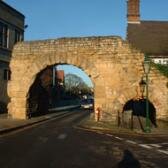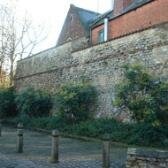Lincoln's Roman Monuments Conservation Plan
Region: East Midlands
Local Authority: Lincoln
Owner Type: Many
Funding Body: City of Lincoln Council English Heritage
Summary: Lincoln's Roman Monuments Conservation Plan: Informing long-term Conservation, Management and Interpretation of significant archaeological remains in Lincoln.
Description: Shortly after the Roman invasion of Britain, Lincoln became a legionary fortress and later an important Roman city. Much has been discovered of Lincoln’s Roman past from excavations and research, and a remarkable number of surviving monuments are still visible today. These include evidence for houses and the water-supply, but the majority of the remains formed part of the city’s defences and forum-basilica (civic centre).
Issue: These Roman monuments make a significant contribution to Lincoln’s special historic character and identity, as well to tourism and to education. The City of Lincoln Council acknowledges that there is a need to protect and enhance the monuments and their settings, and to start to improve public access and enjoyment. The conservation plan was initiated to help inform the long-term conservation, management and interpretation of the monuments and also to coincide with the opening of the new City and County Museum.
Strategy: The plan is one of a family of conservation plans produced in Lincoln in recent years but unlike the subjects of the others; the Roman monuments are many and varied, dispersed around the city, under different ownerships and in varying states of preservation. The monuments needed to be unified in planning terms, necessitating a different approach. The plan was very much a collaborative effort between about 25 different individuals, mainly officers of the City Council but also including the County Council and representatives of the key stakeholder groups (e.g. English Heritage, FLARE, Lincoln Civic Trust Ltd, various owners, etc), with an independent consultant acting as facilitator and editor (Jason Wood, Heritage Consultancy Services). The whole exercise was overseen by a steering group of senior officers from within the City Council and a senior regional representative of English Heritage. It was also exemplary in that the bulk of the community involvement was in ‘real time’, i.e. the consultation evolved as a fully integral part of the plan’s preparation rather than simply being bolted on at the end of the process. The target groups for this consultation were neighbouring residents and businesses, local school children and visitors to the city. In total over 400 people were consulted. Each group was asked a series of open questions that mirrored the conservation plan process and encouraged them to share their knowledge and viewpoints. A number of neighbouring residents also joined with the contributors in attending the working group meetings, and thereby became more directly involved in decision making. This was especially important at the outset of the project.
Outcome: The formal consultation period for the draft plan ended on 1st March 2004. Over 140 responses from local people, and local, regional and national organisations were received. The revised final plan was adopted by City of Lincoln Council and formally launched in December 2004. The work has received critical acclaim from English Heritage, who considers it an exemplary document, particularly with regard to the breadth of consultation during its compilation. Copies of the plan are available from City of Lincoln Council on the link below.
Keywords: Education and Outreach, Management Plans, Publication
© Lincoln City Council/Jason Wood


